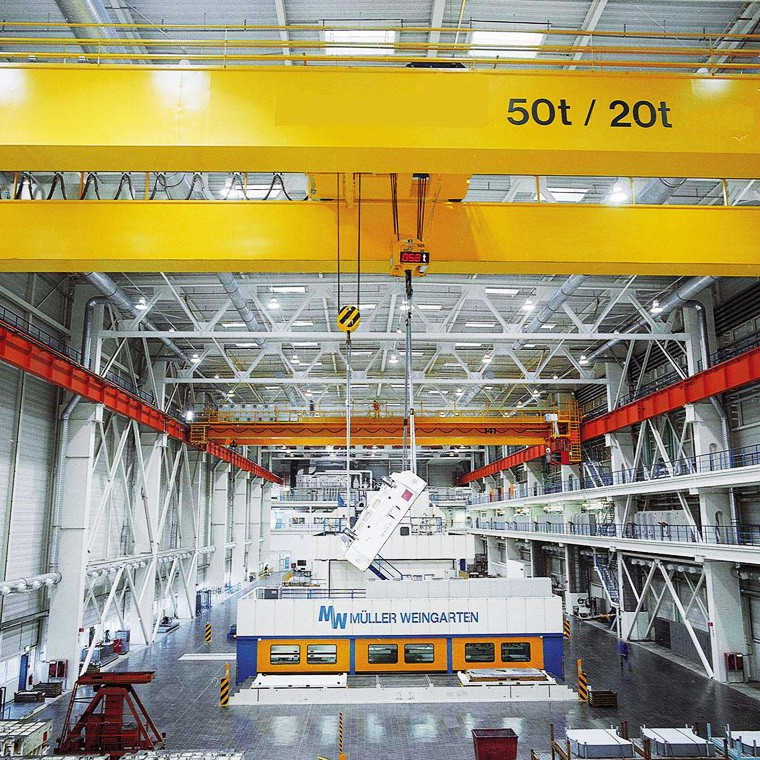Electric Double Girder Double Hook Overhead Crane Installation: A Comprehensive Construction Program
The installation of electric double girder double hook overhead cranes is a critical process in modern industrial production, directly impacting operational efficiency and safety. This specialized construction program is designed to ensure the installation process is efficient, safe, and adheres to strict quality control standards. The program covers all aspects of the installation process, from pre-construction preparation and detailed installation steps to safety measures, quality control, and post-installation maintenance. By implementing this program, we aim to provide a standardized and regulated installation process that enhances production efficiency and safety management for businesses.

1. Construction Program Overview and Objectives
Electric double girder double hook overhead cranes are essential for heavy material handling in industries such as manufacturing, logistics, and construction. This construction program outlines the installation process, pre-construction preparations, safety and quality control measures, resource allocation, and post-installation maintenance requirements. The primary objectives are to ensure a smooth installation process, guarantee the accuracy and safety of the equipment, and ensure the crane operates efficiently and reliably after commissioning.
2. Pre-Construction Preparation and Condition Inspection
Formation and Training of the Construction Team
The construction team is composed of experienced engineers, technicians, and skilled workers. All personnel undergo comprehensive training, including:
- Crane Structure and Features: Understanding the design and components of the crane.
- Installation Procedures: Detailed steps for assembling and installing the crane.
- Safety Protocols: Safe operation practices and emergency response methods.
- Quality Standards: Adherence to national and industry standards.
Equipment and Material Preparation
All necessary equipment and materials are prepared in advance, including:
- Main Components: Main girder, end girder, hoisting mechanism, operating mechanism, and electrical systems.
- Safety Devices: Limit switches, overload protection, and emergency stop buttons.
- Tools and Machinery: Cranes, welding equipment, and measuring instruments.
Inspection of Construction Site Conditions
The construction site is thoroughly inspected to ensure it meets the following conditions:
- Level and Solid Foundation: Ensures stability during installation.
- Obstacle-Free Environment: Prevents interference during construction.
- Infrastructure Availability: Adequate electricity, water, and communication facilities.
- Environmental Factors: Wind, temperature, and humidity are within acceptable limits.

3. Crane Installation Steps and Methods
Foundation Construction and Installation of Embedded Parts
- Site Survey: Conducted to ensure the site meets design requirements.
- Excavation and Pouring: High-strength concrete is used to create a solid foundation.
- Embedded Parts Installation: Installed according to design specifications, with anti-corrosion treatment applied.
Assembly of Main and End Beams
- Connection: High-strength bolts are used to connect the main and end beams.
- Alignment: Measuring instruments ensure parallelism and verticality.
- Adjustments: Any deviations are corrected to ensure stability and precision.
Installation of Lifting and Operating Mechanisms
- Key Components: Motors, reducers, and brakes are inspected and installed.
- Preload and Adjustment: Transmission chains and wire ropes are preloaded for reliability.
- Performance Testing: Ensures all mechanisms operate smoothly.
Installation of Safety Devices and Electrical Systems
- Safety Devices: Limit switches, overload protection, and emergency stop buttons are installed and tested.
- Electrical Systems: Wiring, insulation, and grounding are completed according to electrical safety standards.
- Final Testing: Comprehensive testing ensures all systems meet design requirements.
4. Construction Safety and Quality Control
Safety Measures and Emergency Plans
- Safety Protocols: Strict adherence to safety rules and regulations.
- Protective Equipment: Workers must wear helmets, gloves, and safety glasses.
- Emergency Drills: Regular drills for fire, accidents, and other emergencies.
Quality Control Standards and Inspection Methods
- Process Inspection: Sampling and monitoring of key processes.
- Final Inspection: Comprehensive testing of the crane’s performance and safety features.
- Non-Destructive Testing: Ultrasonic and magnetic particle testing for critical components.
5. Construction Scheduling and Resource Allocation
Construction Progress Plan
- Stages: Foundation construction, equipment assembly, lifting, electrical connections, and testing.
- Time Nodes: Specific deadlines for each stage to ensure timely completion.
- Risk Management: Contingency plans for delays caused by weather, equipment failure, or other factors.
Human Resources and Material Deployment
- Team Composition: Skilled engineers, technicians, and workers.
- Material Management: Scientific inventory management to prevent shortages or waste.
6. Construction Acceptance and Post-Maintenance
Acceptance Criteria and Process
- Appearance Inspection: Check for deformations, weld quality, and painting.
- Performance Testing: Test lifting, lowering, and movement operations.
- Safety Device Verification: Ensure limit switches, overload protection, and emergency stops function correctly.
- Documentation: Detailed records of inspection data and acceptance files.
Post-Maintenance and Maintenance Program
- Regular Maintenance: Inspection, cleaning, lubrication, and tightening of components.
- Replacement of Wearing Parts: Timely replacement of parts like wire ropes and transmission chains.
- Equipment Records: Maintain detailed records of operating conditions and maintenance history.
7. Conclusion
The installation of electric double girder double hook overhead cranes is a complex process that requires meticulous planning, skilled execution, and strict adherence to safety and quality standards. This construction program provides a comprehensive framework for ensuring the crane is installed efficiently, safely, and to the highest quality standards. By following this program, businesses can enhance their production efficiency, ensure operational safety, and extend the lifespan of their equipment. Proper installation and maintenance will ensure the crane operates reliably, supporting the long-term success of industrial operations.
